HABITER ICI LIVING HERE
Portrait de cinq communautés Anishinaabeg
Portrait of five Anishinaabeg communities

Avec le support et la collaboration de : With support and collaboration from :


Le réseau de recherche et de connaissances sur la ville et l’urbain
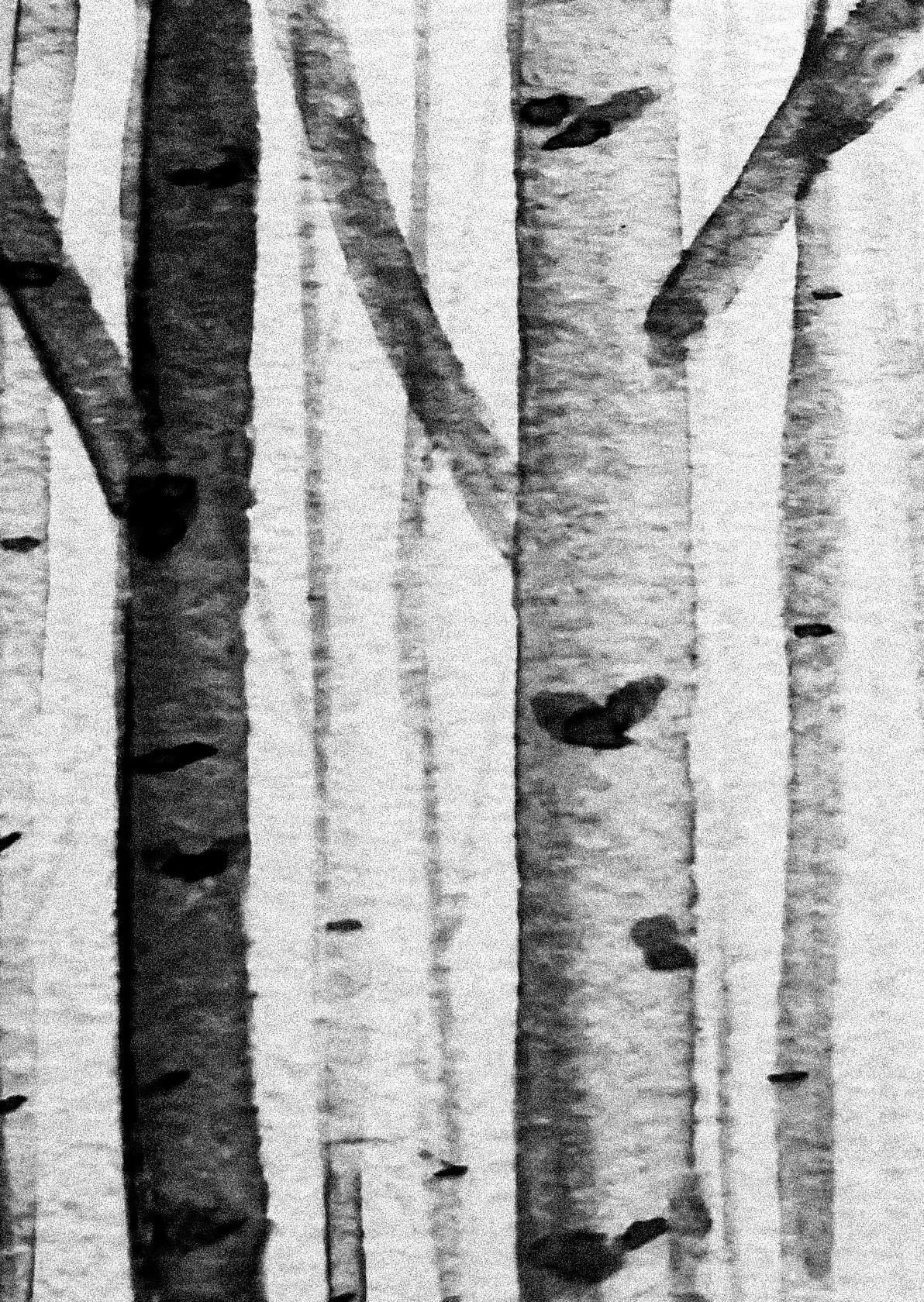
HABITER ICI . LIVING HERE
Coordination : Geneviève Vachon
Édition . Editing : Camille Baril et/and Justine Morin
Équipe . Team : Samuel Boudreault, Elisa Gouin, Myriam Blais, Florence Gagnon, Alice Gascon-Corrivault, Anthony Présumé, Laurence St-Amour, Charlie Wenger, et tous les autres membres . and all the other members.
Remerciements . Acknowledgments : Les collègues de VRM: Hugo Lavallée et Vickie Lefebvre, MTMDQ; Felix Meisels, MCE; Simon Brascoupé, Roue d’orientation.
Tous droits réservés. All rights reserved.
Volume 3, 2023
Groupe Habitats + Cultures, 2023 École d’architecture de l’Université Laval Québec (QC) CANADA G1R 3V6

Crédits photos et textes : Notre équipe a fait preuve de diligence raisonnable dans la recherche des titulaires des droits d’auteur. Toutes les œuvres visuelles ou artistiques se trouvant dans ce document sont reproduites avec l’aimable autorisation des titulaires ou conformément à la Loi sur le droit d’auteur. En cas d’erreur, nous ferons les ajustements pour une prochaine version.

Photo and text credits : Our team has done due diligence in researching copyright owners. All visual or artistic works in this document are reproduced with the kind permission of the copyright holders or in accordance with the Copyright Act. In case of error, we will make adjustments for a future version.
Couverture . Cover : Lac Simon (2021) par Florence Gagnon.

INTRODUCTION
En août 2021, nous sommes partis à la découverte du territoire Anishinaabe, à la rencontre de représentants-es de 5 communautés qui ont eu la gentillesse de nous faire découvrir leur milieu de vie. Pour s’y rendre, il faut rouler sur des routes sans fin, droites comme des flèches, et sur des chemins forestiers qui contournent d’innombrables lacs.
Ce livre aurait pu s’intituler Road 117 puisqu’il rapporte les images d’un premier ‘road trip’ éclair rythmé par de longs déplacements dans le parc de La Vérendrye et par des arrêts mémorables au sein de communautés anishinabeg fières et vigoureuses. Chacune d’elles se distingue dans notre souvenir.
À Pikogan, des professionnels engagés nous ont parlé de programmes ambitieux pendant qu’on parcourait avec eux une communauté dotée d’un grand centre de santé, d’une chouette expo dans la belle église Sainte-Catherine et d’une nouvelle maison des aînés. À Lac Simon, des projets récents démontrent la créativité des gestionnaires qui ont développé des maisons pour familles monoparentales pimpantes et une épicerie qui s’unit au centre communautaire pour animer l’entrée de la communauté. À Kitcisakik, la plage bondée d’enfants baigneurs et de pédalos colorés côtoient une forêt dense où s’invitent les maisons, des rues sinueuses et des vues imprenables sur les lacs. À Kitigan Zibi, on découvre un vaste territoire parsemé de maisons, d’équipements communautaires et de commerces, où les paysages sont variés et familiers à la fois. Et à Rapid Lake, les pins majestueux s’élèvent au-dessus de rues en pente vers le réservoir Cabonga, de maisons variées en attente de rénovation, en marge d’une extension en pleine forêt, interrompue comme une promesse brisée.
Habiter Ici fait suite au portrait des communautés innues du Nitassinan et des villages Inuit du Nunavik (issuu.com/hlnq.linq/docs/habiter-ici_living-here). Ce deuxième volume offre l’opportunité de porter un regard comparatif sur ces milieux de vie à partir de cartes-vignettes à la même échelle. Ce livre est surtout une carte de visite adressée à nos hôtes de Pikogan, Lac Simon, Kitcisakik, Rapid Lake et Kitigan Zibi, en remerciement pour leur partage d’histoires et de passions puisées à leur culture. C’est une invitation au dialogue bricolée à notre façon, avec des cartes, des photos, des dessins et des montages qui brossent un portrait impressionniste, certainement incomplet, où paysages et territoire font partie des acteurs principaux.
Ce road trip marque aussi le début d’une belle collaboration avec la communauté de Rapid Lake autour d’une réflexion concernant l’aménagement d’une éventuelle aire de services, avec l’appui du ministère des Transports et Mobilité durable du Québec et de Villes, Régions, Monde, que nous remercions. Nous remercions bien sincèrement l’ex-chef Tony Wawatie et le conseiller Norman Matchewan pour leurs histoires, leurs idées, leur lucidité, leurs apports aux réflexions en cours, qui ensemble traduisent une conviction profonde envers la justice territoriale.
Megwetch,
Geneviève Vachon
Avec Samuel Boudreault, Élisa Gouin, Florence Gagnon et Anthony Présumé, chercheurs-voyageurs
Et Camille Baril et Justine Morin, collaboratrices à l’édition
Habiter le Nord québécois
École d’architecture de l’Université Laval
Juillet 2022
4
INTRODUCTION
In August 2021, we set out to discover the Anichinabe territory, to meet representatives of 5 communities who were kind enough to share with us their living environment. To get there, you have to drive on endless roads, straight as arrows, and on forest paths that twist around numerous lakes.
This book could have been titled Road 117, as it reports the images of a first road trip punctuated by long journeys through the La Verendrye Reserve and memorable stops in proud and vigorous Anishinabeg communities. Each of them stands out in our memory.
In Pikogan, committed professionals spoke to us about ambitious programs as we toured with them a community with a great health center, an arresting exhibit in the beautiful St. Catherine’s Church and a new seniors’ centre. In Lac Simon, recent projects demonstrate the creativity of local managers who have developed houses for single-parent families and a grocery store that joins the community center to livens the entrance of the community. In Kitcisakik, the beach was crowded with swimming children and colorful pedal boats. Rubbing shoulders with a dense forest where houses, winding streets and breathtaking views of the lakes invite themselves. In Kitigan Zibi, you’ll find a vast territory dotted with homes, community facilities and businesses, where the landscape is both varied and familiar. And in Rapid Lake, majestic pines rise above streets sloping down to the Cabonga reservoir. Homes await renovation, while a future extension into the forest was interrupted like a broken promise.
Habiter Ici follows the portrait of the Innu communities of Nitassinan and the Inuit villages of Nunavik (issuu.com/hlnq.linq/docs/habiter-ici_living-here). This second volume offers the opportunity to take a comparative look at these living environments using thumbnail maps at the same scale. Above all, this book is a visiting card addressed to our hosts from Pikogan, Lac Simon, Kitcisakik, Rapid Lake and Kitigan Zibi, with our thanks for sharing their stories and passions drawn from their culture. It is an invitation to further conversation as cards, photos, drawings and montages paint an impressionistic portrait, certainly incomplete, where landscapes and territory are the main actors.
This road trip also marks the beginning of a promising collaboration with the community of Rapid Lake around a reflection on the development of a possible service area, with the support of the ministère des Transports et Mobilité durable du Québec and of Villes, Régions, Monde, whom we thank. We sincerely thank former Chief Tony Wawatie and Councillor Norman Matchewan for sharing their stories, their ideas and their insight. Their contribution to the reflections in progress translate a deep conviction towards territorial justice.
Megwetch, Geneviève Vachon
With Samuel Boudreault, Élisa Gouin, Florence Gagnon and Anthony Présumé, researchers-travelers
And Camille Baril and Justine Morin, editorial collaborators
5
Living in Northern Quebec School of Architecture of Laval University July 2022
REMERCIEMENTS . ACKNOWLEDGEMENTS
Nebis Polson-Kistabish, Patrick Saint-Jacques (services de première ligne), Romy KistabishRankin, Raphaël Cananasso (travaux publics), Malik Kistabish (directeur services de santé) et Steve Rankin (développement économique), du Conseil de bande de Pikogan; Terry Babin (directeur service d’habitation et des infrastructures), du Conseil de bande de Lac-Simon; Tony Wawatie (ex-chef), Norman Matchewan (conseiller) et Robbie Ratt, du Conseil de bande de Rapid Lake; Régis Penosway (chef), Jimmy Papatie (ex-chef) et Raynald Papatie (santé), du Conseil de bande de Kitcisakik; Christine Steven (directrice générale), du Conseil de bande de Kitigan Zibi; Édith Cloutier (directrice), du Centre d’amitié autochtone de Val d’Or; Julie-Anne Bérubé (formation continue), Lucie Picard (agente de secrétariat), Myriam Trudel (coordonnatrice), Benoit Éthier (professeur-chercheur) et Caroline Morneau (architecte), du Centre d’études autochtones de l’UQAT à Val d’Or; Karine Taillon (architecte), de la firme MLS architecture de Val d’Or.
Merci aux étudiants de l’atelier Habitats et Cultures (M.Arch) de l’ÉAUL de la session Hiver 2022, sous la direction d’Élisa Gouin, avec la collaboration de Sam, Geneviève et plusieurs conférenciers-ères : Maude Boulay, Trisha Brown, Claire Caron, Lyna Chambaz, Sarah-Lou Gagnon-Villeneuve, Claudel Poirier, Maude Senay et Laurie Tremblay. Et plus particulièrement Laurence St-Amour et Charlie Wenger, de même qu’Alice Corrivault-Gascon, qui étaient aussi nos auxiliaires de recherche.
Nebis Polson-Kistabish, Patrick Saint-Jacques (front line services), Romy Kistabish-Rankin, Raphaël Cananasso (public works), Malik Kistabish (director of health services) and Steve Rankin (economic development), of the Pikogan Band Council; Terry Babin (Director of Housing and Infrastructure), from the Lac-Simon Band Council; Tony Wawatie (former Chief), Norman Matchewan (Councillor) and Robbie Ratt, from the Rapid Lake Band Council; Régis Penosway (Chief), Jimmy Papatie (former Chief) and Raynald Papatie (Health), from the Kitcisakik Band Council; Christine Steven (Executive Director), Kitigan Zibi Band Council; Édith Cloutier (Director), Val d’Or Native Friendship Centre; Julie-Anne Bérubé (continuing education), Lucie Picard (secretarial agent), Myriam Trudel (coordinator), Benoit Éthier (professor-researcher) and Caroline Morneau (architect), from the Centre d’études autochtones de l’UQAT in Val d’Or; Karine Taillon (architect), from the firm MLS architecture in Val d’Or
Thanks to the students of Université Laval’s Habitats and Cultures workshop (M.Arch) of the Winter 2022 session, under the direction of Élisa Gouin, with the collaboration of Sam, Geneviève and several speakers: Maude Boulay, Trisha Brown, Claire Caron, Lyna Chambaz, Sarah-Lou Gagnon-Villeneuve, Claudel Poirier, Maude Senay and Laurie Tremblay. And especially Laurence St-Amour and Charlie Wenger, as well as Alice Corrivault-Gascon, who were also our research assistants.
6
7

Rapid Lake
9 Introduction, Geneviève Vachon . Introduction Inspiring words, Norman Matchewan . Mots inspirants Carte d’Anishinaabe Aki . Map of Anishinaabe Aki Carte du Québec . Map of Quebec Comparaison à même échelle des communautés Anishinaabeg, Innues et Inuit . Same scale comparison of Anishinaabeg, Innu and Inuit communities Communautés Anishinaabeg . Anishinaabeg communities Rapid Lake . Kitiganik Pikogan Lac Simon . Cicip Sagahigan Kitcisakik Kitigan Zibi Sources Credits Références . References TABLE DES MATIÈRES TABLE OF CONTENTS 04 14 16 18 21 26 30 44 52 60 72 86 87
La terre est malade, mais elle est encore là. Comme nous.
Pour guérir, elle attend que nous fassions ce qu’il faut pour que ses forêts reprennent vie, ses eaux redeviennent claires, ses animaux retrouvent leur vitalité, ses plantes recommencent à porter la santé. C’est en guérissant nous-mêmes.
Quand le peuple se lèvera et que le grand cercle recommencera à caresser la terre comme avant, les mots algonquins résonneront à nouveau à la grandeur du jardin comme le chant de la terre.
Sans même nous en rendre compte le tambour recommencera à nous faire danser comme de grands oiseaux. Et ce seront nos danses à nous. Parce que nous seront redevenus forts et heureux.
Ce qui est bon pour la terre est toujours bon pour nous. Ce qui est bon pour nous l’est toujours pour la terre.
The earth is sick, but it is still here. Just like us. To heal, she is waiting for us to do what it takes so that her forests come back to life, its waters become clear again, its animals regain their vitality, its plants start to be healthy again. It is by healing ourselves.
When the people rise up and the great circle begins again to caress the earth as before, the Algonquin words will echo once again in the grandeur of the garden as the song of the land.
Without even realizing it the drum will begin again to make us dance like great birds. And it will be our own dances. Because we will be strong and happy again.
What is good for the earth is always good for us. What is good for us is always good for the earth.
10
Ejinagosi (Richard Kistabish) Pour le monde qui aime la terre, 1989

11
La femme qui dessinait sur le sol, © Anthony Présumé Aquarelle réalisée à Rapid Lake, 2021
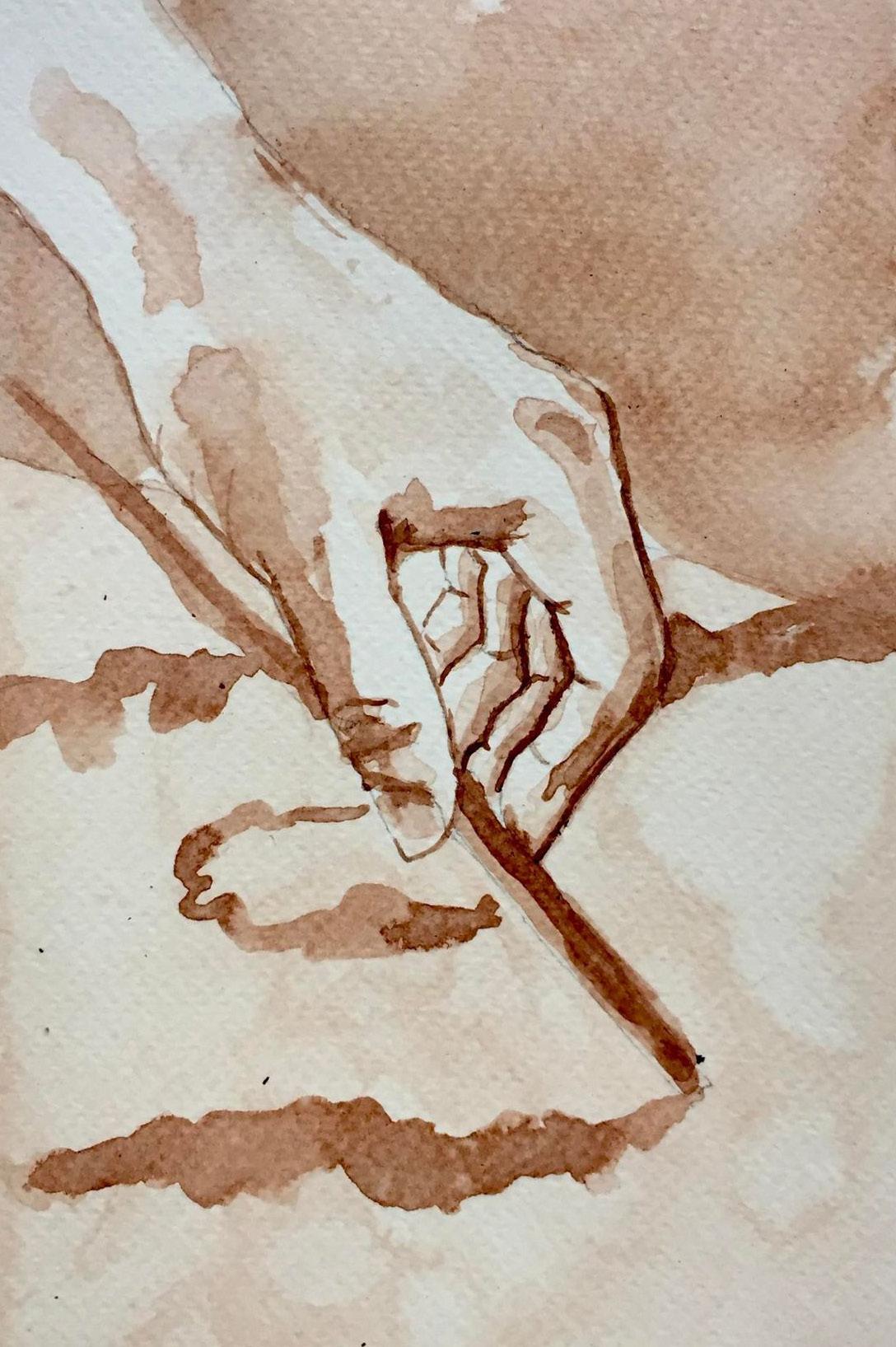
12
La femme qui dessinait sur le sol, © Anthony Présumé Aquarelle réalisée à Rapid Lake, 2021
Nous avons besoin d’actes de restauration, non seulement pour les eaux polluées et les terres dégradées, mais aussi pour notre relation au monde. Nous devons restaurer l’honneur dans notre façon de vivre, afin que lorsque nous traversons le monde, nous n’ayons pas à détourner les yeux de honte, afin que nous puissions garder la tête haute et recevoir la reconnaissance respectueuse du reste des êtres de la terre.
We need acts of restoration, not only for polluted waters and degraded lands, but also for our relationship to the world. We need to restore honor to the way we live, so that when we walk through the world we don’t have to avert our eyes with shame, so that we can hold our heads up high and receive the respectful acknowledgment of the rest of the earth’s beings.
Aimer un lieu n’est pas suffisant. Nous devons trouver des moyens de le guérir.
To love a place is not enough. We must find ways to heal it.
Robin Wall Kimmerer
Tresser les herbes sacrées: Sagesse ancestrale, science et enseignements des plantes, 2021
13
INSPIRING WORDS
“This is ‘ground zero’. It’s not yet a community consultation. In order to spread awareness, support capacity-building, generate economic growth, it begins with being part of the process leading to changes in our community.
In this era of reconciliation, there needs to be an ethical space. Marking our truths and our visions. More people need to be included. We want our voices to be heard. Thinking of our next steps in a sustainable way. Making sure that we can protect our way of life. ”
Norman Matchewan Rapid Lake, 2023
14
MOTS INSPIRANTS
« C’est un “point de départ”. Il ne s’agit pas encore d’une consultation. Afin de sensibiliser l’opinion, de soutenir les capacités locales, et de générer une croissance économique, il faut d’abord faire partie du processus menant aux changements au sein de notre communauté.
En cette ère de réconciliation, il faut un espace éthique. Pour marquer nos vérités et nos visions. Un plus grand nombre de personnes doivent y être incluses. Nous voulons que nos voix soient entendues. Penser à nos prochaines étapes de manière durable. Veiller à ce que nous puissions protéger notre mode de vie. »
Norman Matchewan Rapid Lake, 2023
15
COMMUNAUTÉS ANISHINAABEG COMMUNITIES
Communautés Anishinaabeg communities
Algonquin
Mississauga
Odawa
Chippewa
Ojibway
Potawatomi
Delaware
Sources : www.anishinabek.ca www.native-land.ca
BAIE D’HUDSON
QUÉBEC ONTARIO
DAKOTA DU NORD DAKOTA DU SUD MINNESOTA WISCONSIN MICHIGAN NUNAVUT
MANITOBA
LAC HURON LAC SUPÉRIEUR LACÉRIE LAC ONTARIO BAIE GEORGIENNE L A C MICHIGAN NUNAVIK 55° Sudbury Toronto Détroit Chicago Thunder Bay Winnipeg ANISHINAABE AKI Kuujjuaq

COMMUNAUTÉS ANISHINAABEG, INNUES, INUIT, CREE COMMUNITIES
COMMUNAUTÉS ANICINABEG, INUIT ET INNUES AU QUÉBEC
Ivujivik
Akulivik
Salluit
Puvirnituq
Inukjuak
Kangiqsujuaq
Quaqtaq
Kangirsuk
Aupaluk
Tasiujaq
Kuujjuaq
Kangiqsualujjuaq
Umiujaq
Kuujjuarapik
Whapmagoostui
Chisasibi
Wemindji
EEYOU ISTCHEE
Eastmain
BAIE-JAMES
Nemaska
Waskaganish
Pikogan
Rouyn-Noranda
Timiskaming
Winneway
Wolf lake
Mistissini
Oujé-Bougoumou
Waswanipi
Lac Simon
Kitcisakik
Sche erville
Matimekush
Fermont
NITASSINAN
Pessamit
Mashteuiatsh Essipit
Saguenay
ANISHINAABE AKI
Rapid Lake
Eagle Village
Québec
Kitigan Zibi
Montréal
Pakua Shipu
Unamen-Shipu
Ekuanitshit Mani-Utenam Uashat
Sept-Îles
Nutashkuan
Gaspé
18
N
NUNAVIK
All that we are is story. From the moment we are born to the time we continue on our spirit journey, we are involved in the creation of the story of our time here.
It is what we arrive with. It is all we leave behind.
We are not the things we accumulate. We are not the things we deem important.
We are story. All of us.
What comes to matter then is the creation of the best possible story we can while we’re here; you, me, us, together.
When we can do that and we take the time to share those stories with each other, we get bigger inside, we see each other, we recognize our kinship we change the world, one story at a time.
Tout ce que nous sommes est une histoire. Depuis le moment où nous sommes nés jusqu’au moment où nous continuons notre voyage spirituel, nous sommes impliqués dans la création de l’histoire de notre passage ici.
C’est ce avec quoi nous arrivons. C’est tout ce que nous laissons derrière.
Nous ne sommes pas les choses que nous accumulons. Nous ne sommes pas les choses que nous jugeons importantes.
Nous sommes une histoire. Nous tous.
Ce qui devient important alors c’est la création de la meilleure histoire possible
pendant que nous sommes ici ; toi, moi, nous, ensemble.
Quand on peut faire ça et que nous prenons le temps de partager ces histoires avec l’autre, nous devenons plus grands à l’intérieur, nous nous voyons les uns les autres, nous reconnaissons notre parenté nous changeons le monde, une histoire à la fois.
Richard Wagamese Medicine Walk, 2014
19



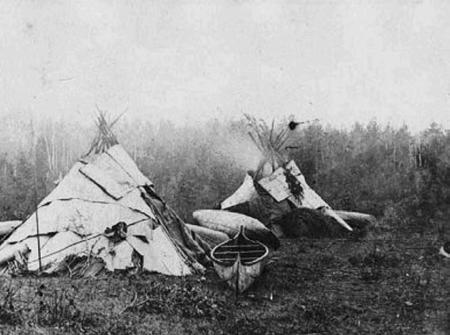



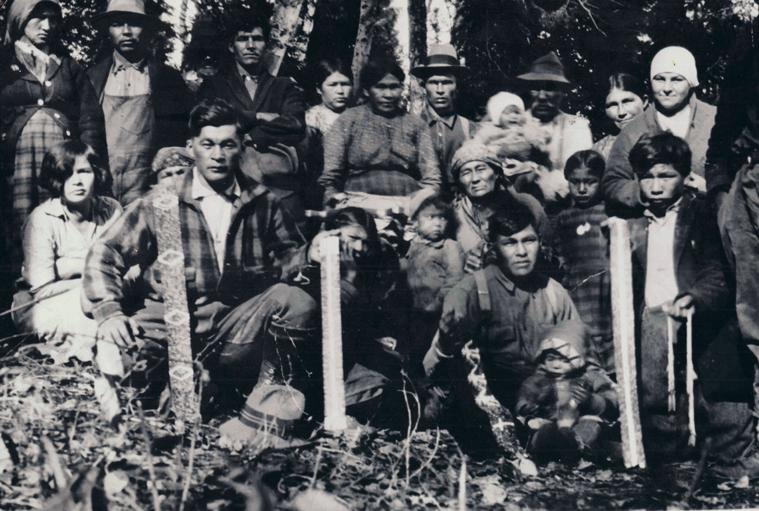
20 1 2 3 4 5 6 7 8 Archives : communautés anishinaabeg
COMMUNAUTÉS ANISHINAABEG, INNUES, INUIT COMMUNITIES
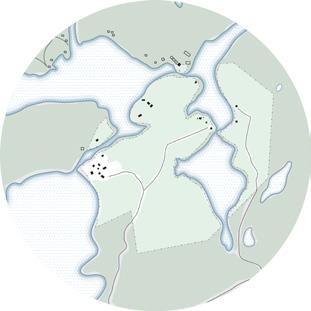


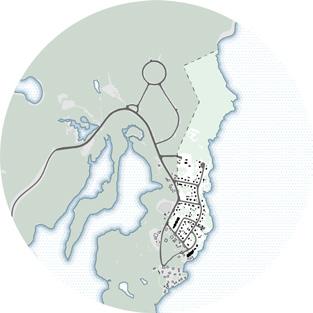





21
Kitigan Zibi
Timiskaming
Rapid Lake
Winneway
Eagle Village
Wolf Lake
Lac Simon
500m
Pikogan Kitcisakik


500m
ANICINAPE
ANISHNAPE ANICHINABÉE ANICHINABÉS ANICINABE ANICINAPE
ANICINABE ANICINAPE ANICINABE ANICINAPE
ANISHNAPE ANICHINABÉE ANICHINABÉS ANICINABE ANICINAPE
ANICHINABÉE ANICHINABÉS ANICINABE ANICINAPE
ANISHNABE ANISHNAPE ANICHINABÉE ANICHINABÉS ANICINABE ANICINAPE
ANICHINABÉS ANICINABE ANICINAPE
ANISHNAABE ANISHNABE ANISHNAPE ANICHINABÉE ANICHINABÉS ANICINABE ANICINAPE
ANISHNABE ANISHNAPE ANICHINABÉE ANICHINABÉS ANICINABE ANICINAPE
ANICHINABÉS ANICINABE ANICINAPE
ANICINAP ANICHINABÉS ANICINABE ANICINAPE
ANISHNAPE ANICHINABÉE ANICHINABÉS ANICINABE ANICINAPE
ANICHINABÉS ANICINABE ANICINAPE
ANISHNAPE ANICHINABÉE ANICHINABÉS ANICINABE ANICINAPE
ANICHINABÉS ANICINABE ANICINAPE
ANICINAPE
ANIMKII THUNDERBIRD
OISEAU-TONNERRE
L’oiseau-tonnerre est considéré comme un des esprits les plus nobles dans la mythologie anishinaabe. Symbole de la culture, cet oiseau surnaturel produit le tonnerre et les éclairs, veille à la santé et au bien-être sur Terre.
The thunderbird is considered one of the most noble spirits in the Anishinaabe mythology. As a cultural symbol, this supernatural bird produces thunder and lightning, and watches over the health and well-being on earth.
24
ANICHINABÉ
ANISHINAABE ANISHNABE ANISHNAPE ANICHINABÉE ANICHINABÉ ANICINABE ANICINAPE ANISHINAABE
ANICHINABÉE ANICHINABÉ ANICINABE ANICINAPE ANISHINAABE ANISHNABE ANISHNAPE ANICHINABÉE ANICHINABÉ
ANISHINAABE ANISHNABE ANISHNAPE ANICHINABÉE ANICHINABÉ ANICINABE ANICINAPE ANISHINAABE ANISHNABE ANISHNAPE
ANISHNAPE ANICHINABÉE ANICHINABÉ ANICINABE ANICINAPE ANISHINAABE ANISHNABE ANISHNAPE ANICHINABÉE
ANISHNABE ANICHINABÉEANISHINAABE ANISHNABE ANISHNAPE ANICHINABÉ ANICINABE ANICINAPE
ANISHINAABE ANISHNABE ANISHNAPE ANICHINABÉE ANICHINABÉ ANICINABE ANICINAPE ANISHINAABE ANISHNABE
ANISHINAABE ANISHNABE ANISHNAPE ANICHINABÉ ANICINABE ANICINAPE ANISHINAABE ANISHNABE ANISHNAPE ANICHINABÉE
ANISHINAABE ANICHINABÉE ANISHINAABE ANICINABE ANICINAPE ANISHINAABE ANISHNABE ANISHNAPE ANICHINABÉE
ANISHINAABE ANISHNABE ANISHNAPE ANICHINABÉE ANICHINABÉ ANICINABE ANICINAPE ANISHINAABE ANISHNABE
ANISHNABE ANISHNAPE ANICHINABÉE ANICHINABÉ ANISHINAABE ANISHNABE ANISHNAPE ANICHINABÉE ANICHINABÉ
ANISHNAPE ANISHINAABE ANISHNABE ANISHNAPE ANICHINABÉE ANICHINABÉ ANICINABE ANICINAPE
ANISHINAABE ANISHNABE ANISHNAPE ANICHINABÉE ANICHINABÉ ANICINABE ANICINAPE ANISHINAABE ANISHNABE ANISHNAPE
ANISHNABE ANISHNAPE ANICHINABÉE ANICHINABÉ ANICINABE ANICINAPE ANISHINAABE ANISHNABE
ANISHNABE ANISHNAPE ANICHINABÉE ANISHINAABE ANISHNABE ANISHNAPE ANICHINABÉE ANICHINABÉ ANICINABE
ANICINABE ANISHINAABE ANISHNABE ANISHNAPE ANICHINABÉE ANICHINABÉ ANICINABE
ANISHNAPE ANICHINABÉE ANICHINABÉ ANISHINAABE ANISHNABE ANISHNAPE ANICHINABÉE ANICHINABÉ
ANICINAPE ANICHINABÉ ANICINABE ANICINAPE ANISHINAABE ANISHINAABE ANISHNABE ANISHNAPE
ANISHNABE ANISHNAPE ANICHINABÉE ANICHINABÉ ANISHINAABE ANISHNABE ANISHNAPE ANICHINABÉE ANICHINABÉ
ANISHNAPE ANICHINABÉE ANICHINABÉ ANISHINAABE ANISHNABE ANISHNAPE ANICHINABÉE ANICHINABÉ ANICINABE
ANISHNABE ANISHNAPE ANICHINABÉE ANICHINABÉ ANICINABE ANICINAPE ANISHINAABE ANISHNABE ANICHINABÉ ANISHNAPE
ANISHINAABE ANISHNABE ANISHNAPE ANICHINABÉE ANICHINABÉ ANICINABE ANICINAPE ANISHINAABE ANISHNABE ANISHNAPE
ANISHINAABE ANISHNABE ANISHNAPE ANICHINABÉE ANICHINABÉ ANICINABE ANICINAPE ANISHINAABE
ANISHINAABE ANICHINABEE ANICHINABÉ ANICINABE ANICINAPE ANISHINAABE ANISHNABE
ANISHNABE ANISHNAPE ANICHINABÉE ANICHINABÉ ANICINABE ANICINAPE ANISHINAABE ANISHNABE ANISHNAPE
ANISHINAABE ANISHNAPE ANICHINABÉE ANICHINABÉ ANICINABE ANICINAPE ANISHINAABE ANISHNABE ANISHNAPE
ANISHINAABE ANISHNABE ANICHINABÉE ANISHINAABE ANISHNABE ANISHNAPE ANICHINABÉE ANICHINABÉ ANICINABE ANICINAPE
ANISHNABE ANISHNAPE ANICHINABÉE ANICHINABÉ ANICINABE ANICINAPE ANISHINAABE ANISHNABE ANICINAPE ANISHINAABE
ANICHINABÉE ANISHINAABE ANICHINABÉE ANICHINABÉ ANICINABE ANICINAPE ANISHINAABE ANISHNABE ANISHNAPE ANICHINABÉE
ANISHINAABE ANISHNABE ANISHNAPE ANICHINABÉE ANICHINABÉ ANICINABE ANICINAPE ANISHINAABE ANISHNABE ANICHINABÉ
ANISHNABE ANISHNAPE ANICHINABÉE ANICHINABÉ ANISHINAABE ANISHNABE ANISHNAPE ANICHINABÉE ANICHINABÉ
ANISHINAABE ANISHNABE ANISHNAPE ANICHINABÉE ANICHINABÉ ANICINABE ANICINAPE
ANISHINAABE ANISHNABE ANISHNAPE ANICHINABÉE ANICHINABÉ ANICINABE ANICINAPE ANISHINAABE ANISHNABE ANISHNAPE
ANISHINAABE ANISHNABE ANISHNAPE ANICHINABÉE ANICHINABÉ ANICINABE ANICINAPE ANISHINAABE ANISHNABE
ANISHINAABE ANISHNABE ANISHNAPE ANICHINABÉE ANISHINAABE ANISHNABE ANISHNAPE ANICHINABÉE ANICHINABÉ
ANICHINABÉ ANICINABE ANISHINAABE ANISHNABE ANISHNAPE ANICINABE ANICINAPE ANISHINAABE
ANISHNABE ANISHNAPE ANICHINABÉE ANICHINABÉ ANISHINAABE ANISHNABE ANISHNAPE ANICHINABÉE ANICHINABÉ ANICINAPE
ANICINABE ANICINAPE ANICHINABÉ ANICINABE ANICINAPE ANISHINAABE ANISHINAABE ANISHNABE ANISHNAPE ANICHINABÉE
ANISHNABE ANISHNAPE ANICHINABÉE ANICHINABÉ ANISHINAABE ANISHNABE ANISHNAPE ANICHINABÉE ANICHINABÉ
ANICINAPE ANICHINABÉ ANICINABE ANICINAPE ANISHINAABE ANISHINAABE ANISHNABE ANISHNAPE ANICHINABÉE
ANISHNABE ANISHNAPE ANICHINABÉE ANICHINABÉ ANISHINAABE ANISHNABE ANISHNAPE ANICHINABÉE ANICHINABÉ
ANICINABE
ANICINAPE ANISHINAABE ANISHNABE ANISHNAPE ANICHINABÉE ANICHINABÉ

26 Kitcisakik
ANISHINAABE AKI
27


28
Art urbain à Winneway , Frank Polson © Minwashin.org
L’eau et le bateau, © Anthony Présumé Aquarelle réalisée à Rapid Lake, 2021
On n’hérite pas de la terre de nos parents
On l’emprunte à nos enfants
De toute façon la terre n’est pas à nous
On est à elle, on forme un tout
Ici, je suis qu’une âme passagère
Je suis un enfant de la terre
Niang loueu ni ho (D’où venons-nous?)
Kiang loueu ni m’beiga hoho (D’où venez-vous?)
Kiang ere nie ho (Où allez-vous?)
Niang ere nie ho (Où allons-nous?)
Traa koni ong ho (Ce n’est pas notre terre)
Traa kogeng ong n’dang kong ba (Ce n’est ni la vôtre)
Na n’da be krandeni kang ho (Laissons-la à nos enfants)
Ka ere youeugu’a m’bei ho (Pour qu’ils la cultivent encore)
We do not inherit the land from our parents
We borrow it from our children
Anyway the land is not ours
We belong to it, we form a whole
Here, I am only a passing soul I am a child of the earth
Niang loueu ni ho (Where do we come from?)
Kiang loueu ni m’beiga hoho (Where do you come from?)
Kiang ere nie ho (Where are you going?)
Niang ere nie ho (Where are we going?)
Traa koni ong ho (This is not our land)
Traa kogeng ong n’dang kong ba (This is not yours either)
Na n’da be krandeni kang ho (Let’s leave it to our children)
Ka ere youeugu’a m’bei ho (For them to cultivate it again)
Samian Enfant de la terre
La plume d’aigle, 2015
29
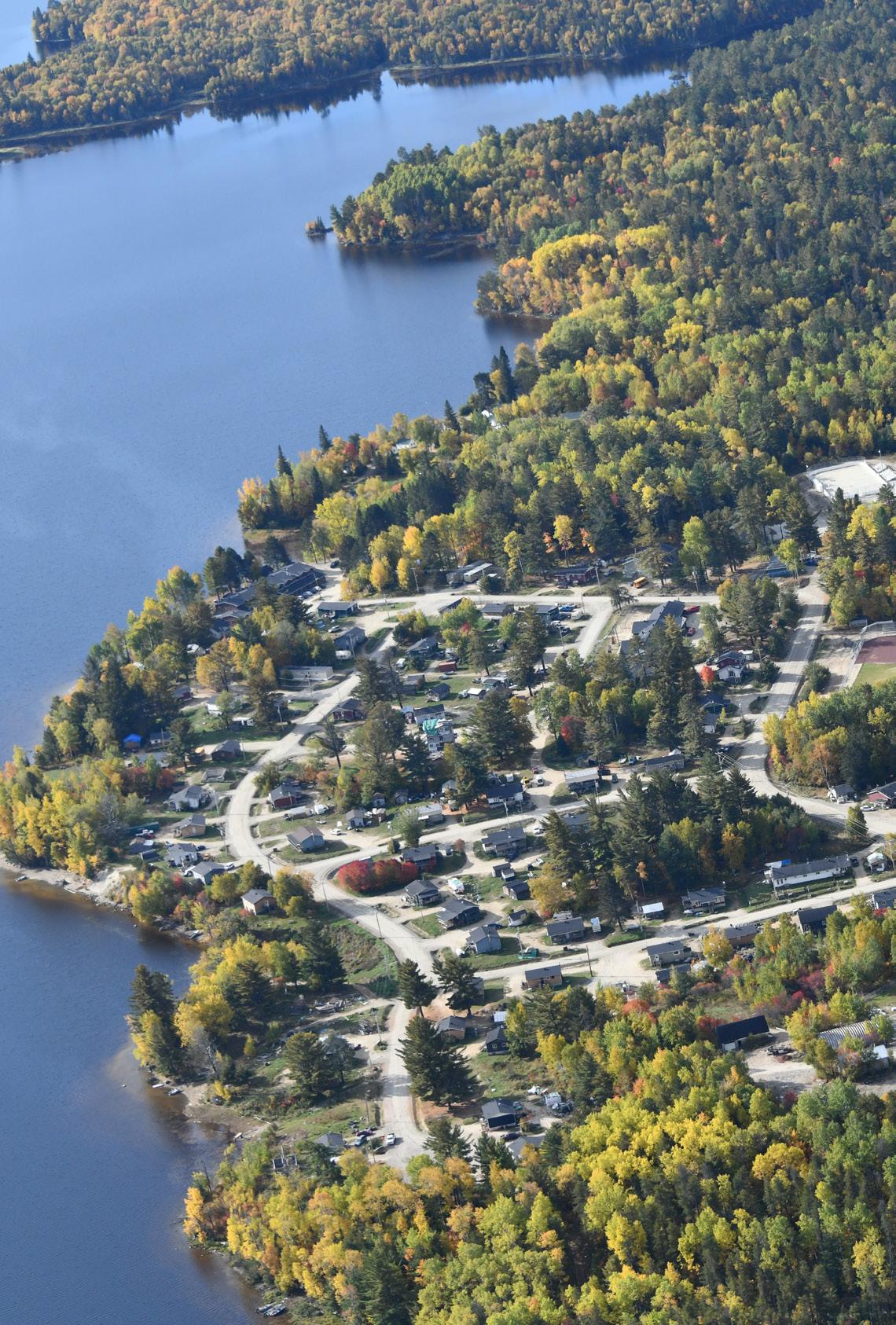
30 Rapid Lake
RAPID LAKE KITIGANIK garden

31
32 Territory of Rapid Lake as shaped by dams LMi 2 1 3 4 5 6 7 La Vére n d r ey 72 L a V é r e n d r y e 2 9 Rte 117 8
HYDROGRAPHIC TERRITORY OF RAPID LAKE
1. Rapid Lake community
Communauté de Rapid Lake
2. Rotem Dam
Barrage Rotem
3. Andou Dam
Barrage Andou
4. Wagoose-3 Dam
Barrage Wagoose-3
5. Burial site
Lieu de sépulture
6. Barriere Dam
Barrage Barriere
7. Cultivated land, Hudson’s Bay Company post and missionary chapel (1894)
Terrain cultivé, poste et chapelle des missionnaires de la Compagnie de la Baie d’Hudson (1894)
8. Barriere Lake community (1894) Communauté de Lac Barrière (1894)
9. Hudson’s Bay Company post and chapel (first half of 19th century) Poste et chapelle de la compagnie de la Baie d’Hudson (1e moitié du 19e siècle)
10. Cabonga Dam
Barrage Cabonga
11. Travers Dam
Barrage Travers
Hydrography 2022 (flooded areas)
Hydrographie 2022 (zones innondées)
Hydrography 1894
Hydrographie 1894
Source : Canada - Mines and technical surveys
33 1km N
10 11 9
10
Abitibi-Témiscamingue
34 Traditional territory of Rapid Lake Outaouais
Kitcisakik
Lac Simon
La WildlifeVerendryeReserve Val-d’Or
Rapid Lake
Le Domaine
Algonquins of Barriere Lake
Traditional Territory
(Trilateral Agreement 1991)
Traditional Management Areas (7 families)
Laurentides
35
Mauricie
Maniwaki
Rte117
36 9 14 8 7 6 15 1 3 4 5 10 2 11 12 13 Rapid Lake community Rapid Bay Val-d’Or(160km) La Vérendrye 27
Cabonga Reservoir
RAPID LAKE KITIGANIK
47.2553,-76.7074
622 inhabitants . habitants
0,28 km2
RTE 117 ROAD
160 km from/de Val-d’Or
AMENITIES / ÉQUIPEMENTS :
1. Expansion (suspended)
Extension (interrompue)
2. Burial site
Lieu de sépulture
3. Diesel power station
Centrale diesel
4. Kitiganik elementary school
École primaire de Kitiganik
5. Baseball field
Terrain de baseball
6. Pumping station
Station de pompage
7. Fire station
Caserne de pompiers
8. Community space
Espace communautaire
9. Gymnasium
Gymnase
10. Skating rink
Patinoire
11. Teacher residence
Résidence des professeurs
12. Daycare center
Garderie
13. Wellness center
Centre de soins
14. Health center
Centre de santé
15. Band office
Conseil de bande
*2016
37 N 100m
Statistique Canada Statistic
Barriere Lake: Territory of Resistance


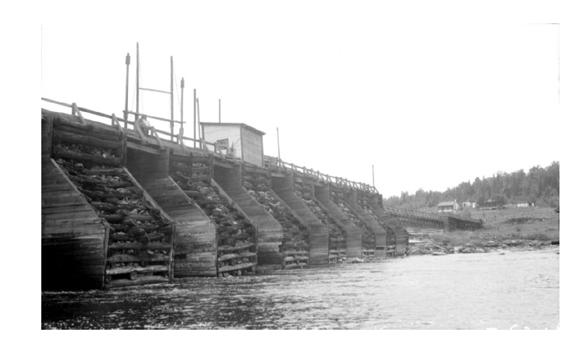


“They’re clear-cutting our way of life”

Activism Rising
Royal ProclamationTreatyof Niagara Canadian Confederation IndianAct Residential schools (18701990) Indigenousrighttovotein Canada ComprehensiveLand Claims Calder Case:Aboriginal ownershiptitle JamesBayand NorthernQc Agreement FirstQuebec independence Referendum ConstitutionAct Raidsat Restigouche,





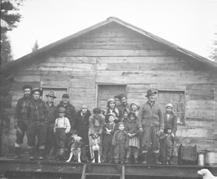
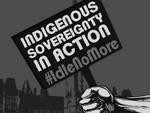


Agreement
Imposed Interim Band Council and first Third Party Management (TPM) appointed Bilateral Agreement
Mitchikanibikok Anishinabe Onakinakewin: traditional oral rule codified


Good Faith Is Not Enough
lands Second Quebec independence Referendum WhiteandRed Papers Righttovotein
CrisisFourthWorld Royal Commissionon Aboriginal Peoples DelgamuukwCase: Aboriginaltitle ofownershipoft




38
1929 1991 Trilateral
Integrated Resource Management Plan (IRMP) Dams : Major Flood at Barriere Lake
1760 1870 1940 1950 1961 1990 1996 1999 1997 1998
Quebec 1995
Côte-Nord Oka
raditional
1763 1764 1876 1867 1973 1975 1969 1960 1980 1982 1981
Anishinabeg Devastating clear-cut loggings 1760 1870 1950 1961 1940 Intensification of claims for land protection and control Road 117 blockade (August 20th) Road 117 La Verendrye Park: tourism intensify Rapid Lake reserve establishment 1970 - 1990 1990 1997 1997 1998 1996 - 1997 mid 1990’s mid 1990’s - 2001 Expansion Plan, collaboration
Three-Figure Wampum: symbol of agreement between French, English and
Memorandum of Mutual Intent with proposal to rebuild the community Discord within the community and Canadian government interference
Wawatie
ChiefJ -M Matchewan Chief H
Manifestations and road blockades for application of signed agreements and respect of self-governance: SQ violent response

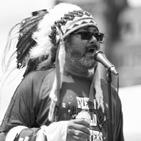






Land protection camp against clear-cut logging : consultation and harmonisation


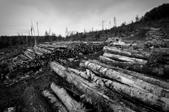
2022
Canadian Center for Architecture (CCA) master student program: Healing and building at Barriere Lake


Second TPM appointed
FirstNations Fiscal ManagementActUNDeclarationonthe Rightsof The Invisible Nation (Richard Desjardins)
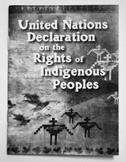

Copper One saga: mining claims on the land

Imposed Band Council (Indian Act), replacing Traditional Customary Council


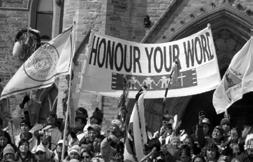
Negociations to apply 2006 seven joint recommendations TPM replaced by co-management with fiscal company
Memorandum on moose management

2021
Agreement expectations: reserve expansion, economic development, housing, etc.
U. Laval workshop: development and service station scenarios (with MTQ) Chief C

First Nations FinancialTransparency Act Honouryourword (Martha Stiegman) Investigationinto police abuseofindigenouswomeninVal d’Or Joyce Echaquan ’sdeath:Waveof supportfor indigenous causes Bodiesof indigenous children discovered near Canadian residential schools National Inquiryinto Missingand Murdered Grounded Authority (Shiri Pasternak) IndigenousWomenandGirls (2016-2019)

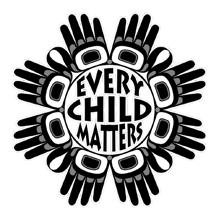
Rapid Lake history timeline
Marqueurs de l’histoire de Rapid Lake Par.by Charlie Wenger & Laurence St-Amour, 2022
39 2001 2006 2021 Canada Unilaterally Withdraws from all Agreements End of Efforts with IRMP Implementation Agreement of the 2006 Joint Recommendations Latency Honour Your Word Renewed Hope 2002 2010 2018 2008 2012 2013 2021 2022 2017
2005 2007 2015 2019 2020 theindigenous Peoples 2008 2021 2013 2012 - 2017 mid 2010’s 2010 2018 2006 -2018 recommendations Ciaccia-Lincoln
1999 Agreement in Principle on reserve expansion Scenario for Joint Consideration
Ratt
Councilor N Matchewan Sp o kesperson M Poucachich e
R.Nottaway
If any information appears inaccurate, please notify the authors @ : habiterlenordquebecois@ulaval.ca
Chief T Wawatie
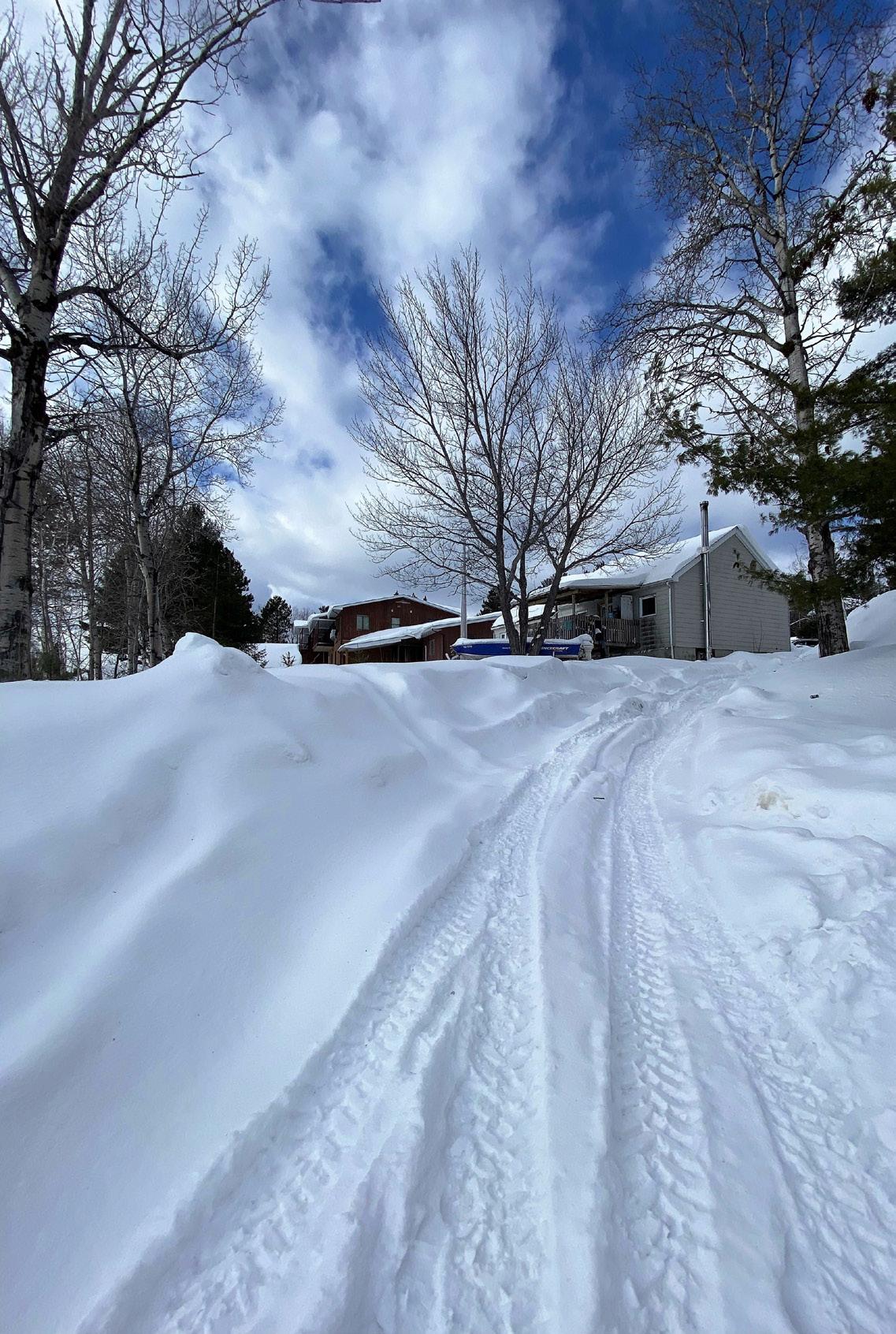
40 Rapid Lake




41 Rapid Lake
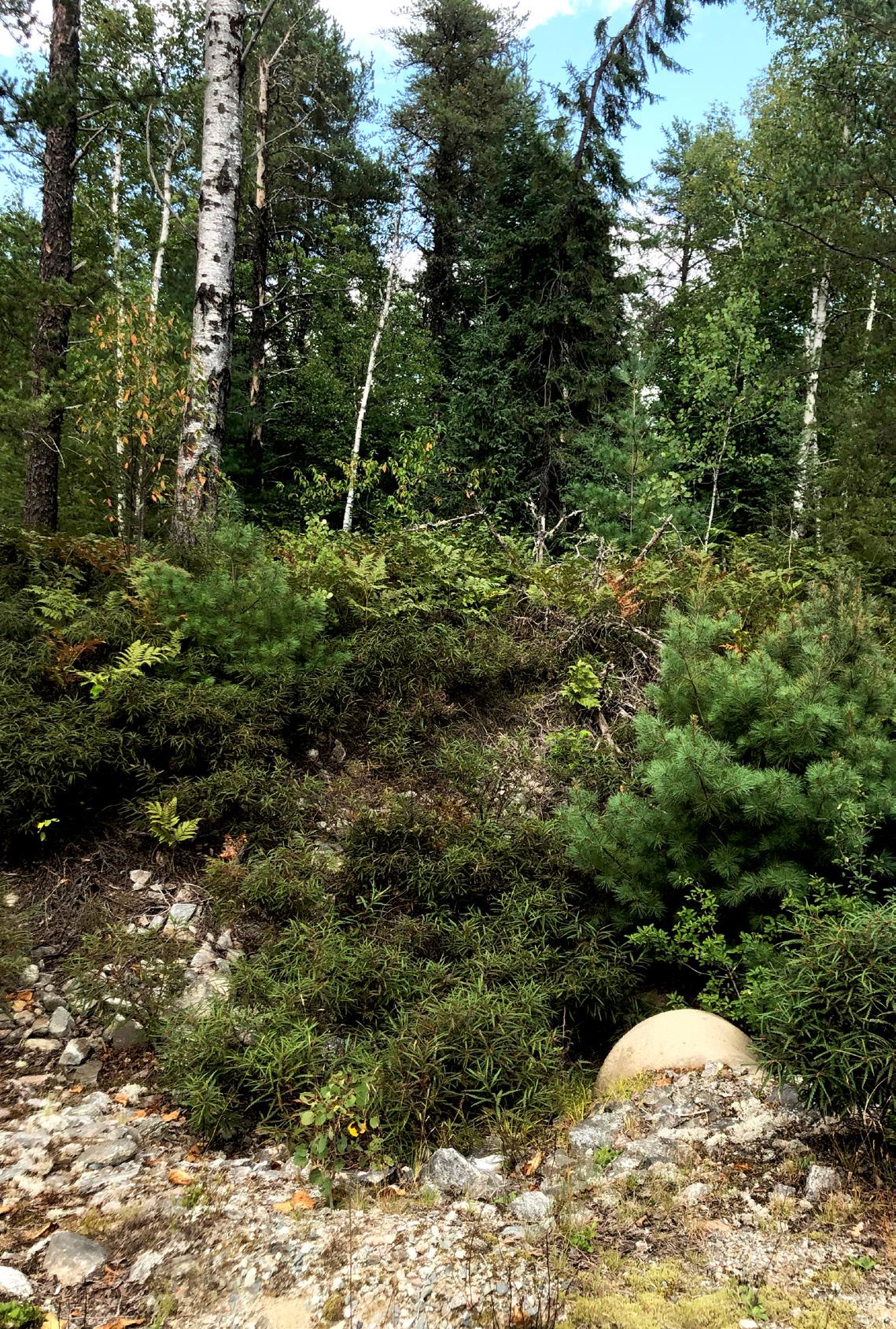
42 Rapid Lake
AKI TERRE
« [Ma kokoum] ne m’a pas enseigné en me commandant de ‘faire ceci’ ou de ‘faire cela’, mais me faisait l’observer. Beaucoup d’observation sans faire quoi que ce soit, juste observer. Parfois, si elle avait besoin d’aide, je l’aidais, mais la plupart du temps, elle m’enseignait par l’exemple et c’est ainsi que nous étions éduqués : par l’observation et l’écoute. »
“ [My kokoum] did not teach me by ordering me to ‘do this or ‘do this’, but made me observe it. A lot of observation without doing anything, just observing. Sometimes, if she needed help, I would help her, but most of the time, she would teach me by example and that’s how we were that’s how we were educated: by observing and listening. ”
MINOTEIPARTAGE, GÉNÉROSITÉ
Grace Ratt
© Marie-Raphaëlle LeBlond minwashin.org

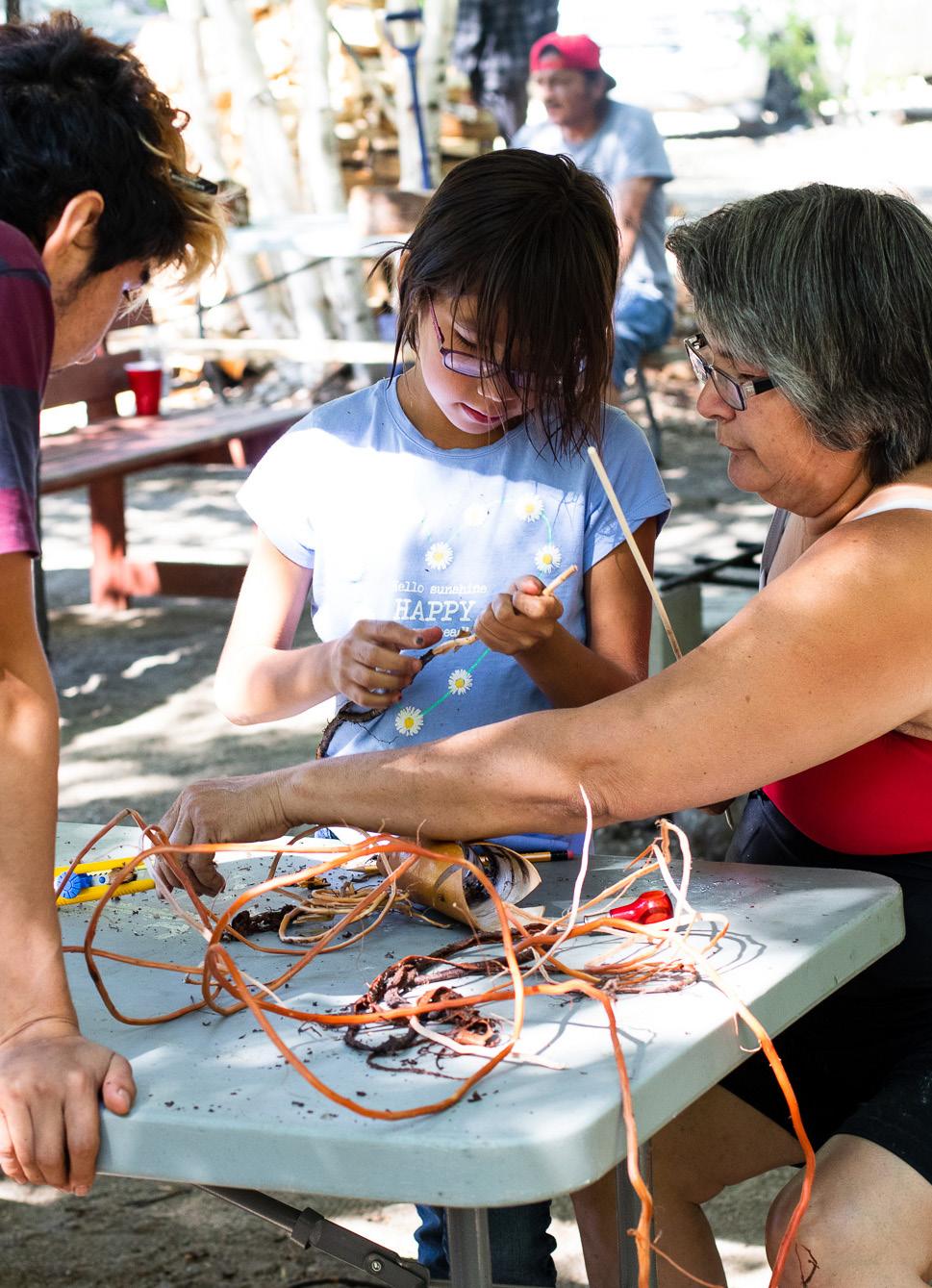

43

44 Pikogan

45
PIKOGAN tipi
46 12 17 9 10 11 13 14 15 16 18 Communauté de Pikogan
Amos(3km)
PIKOGAN
48.5971, -78.1126
540 habitants . inhabitants
2,74 km2
RTE 109 ROAD
74 km from/de Val-d’Or
165 logements . dwellings
ÉQUIPEMENTS / AMENITIES :
1. Église Sainte-Catherine Saint-Catherine church
2. Corporation du dév. économique Economic dev. corp. Amik
3. Maison des jeunes Youth club
4. Radio communautaire Community radio
5. Supérette Convenience store
6. Station-service et dépanneur Service station
7. Poste de police Police station
8. Hôtel Hotel
9. Terrain de jeux Playground
10. École Migwan Migwan school
11. Conseil de bande Band office
12. Centre de la petite enfance Mokaan
Mokaan daycare center
13. Centre de formation, emploi et développement social Center for Training, Employment and Social Development
14. Centre de santé Wellness center
15. Maison pour aînés Helder’s house
16. Aréna Arena
17. Centre communautaire Minawasi Minawasi community center
18. Atelier municipal Community workshop
*2021 Statistique Canada Statistic
47 1 3 4 5 8 7 2 6 N
100m
Rivière Harricana Rte109N

48 Pikogan
La leçon de [Richard Ejinagosi] Kistabish vaut bien celles de plusieurs grands philosophes.
Il nous dit que le sauvage est beau. Nous aurions besoin aujourd’hui, mal pris comme nous le sommes, de plus de pensées sauvages, de plus d’espaces sauvages, d’une bonne dose de liberté sauvage.
The lesson by [Richard Ejinagosi] Kistabish is as good as those of many great philosophers.
He tells us that the savage is beautiful. We could use some of that today, troubled as we are, of more savage thoughts, more savage spaces, a good dose of savage freedom.
Serge Bouchard Un café avec Marie , 2021
49





50
Enfant métissé dans un monde divisé, je n’ai pas choisi mon camp, j’ai choisi de les tisser.
Child of mixed-race in a divided world, I didn’t choose my side, I chose to weave them.
51
Samian 2022
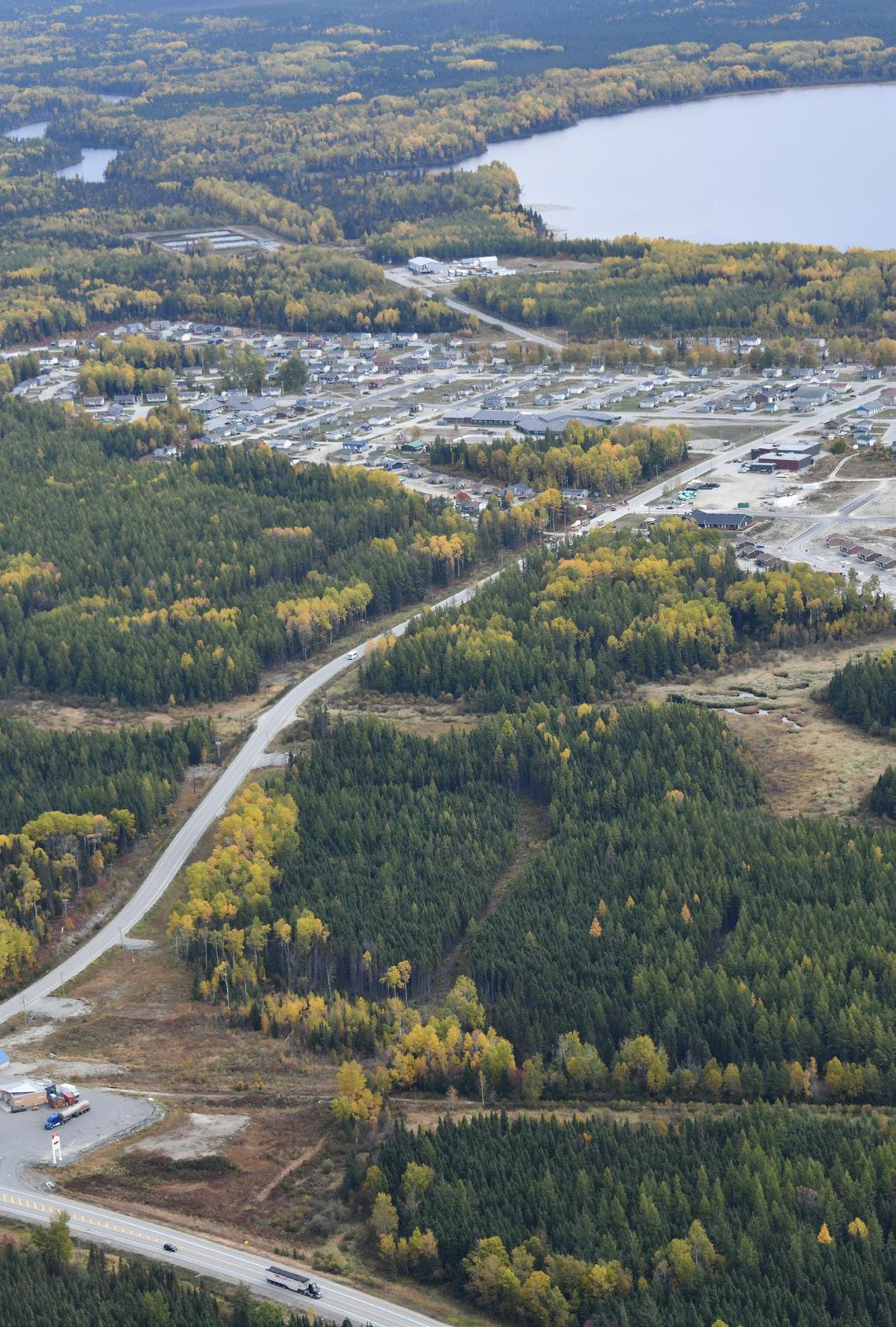
52 Lac Simon
LAC
SIMON CICIP SAGAHIGAN le lac au canard

53
54 7 8 2 17 10 6 1 11 9 18 9 9 5 4 3 Communauté de Lac Simon Rte 117 Mon t r éa l ( 4 9 1 k m ) Vla’d O r 73( )mk
Lac Simon
LAC SIMON
CICIP SAGAHIGAN
48.0539, -77.3365
1 285 habitants . inhabitants
6,81 km2
RTE 117 ROAD
37 km from/de Val-d’Or
343 logements . dwellings
ÉQUIPEMENTS / AMENITIES :
1. Centre de la petite enfance
Daycare center
2. Centre de santé
Health center
3. Corporation du dév. économique
Economic dev. corp. Wabak Pimadizi
4. Poste de police Police station
5. Maison des aînés
Elder’s house
6. Centre communautaire
Community center
7. Épicerie Wabak
Wabak market
8. École secondaire Amik-Wiche
Amik-Wiche high school
9. Terrain de jeux Playground
10. Conseil de bande Band office
11. Centre de formation Training center
12. Église Church
13. Pumptrack
14. Espace communautaire
Community space
15. Ateliers travaux publics
Municipal public workshops
16. Station de traitement des eaux usées
Wastewater treatment plant
17. École primaire Amikobi
Amikobi primary school
18. Station-service
Gas station
*2021 Statistique Canada Statistic
55
N 12 15 13 1 14 16
100m
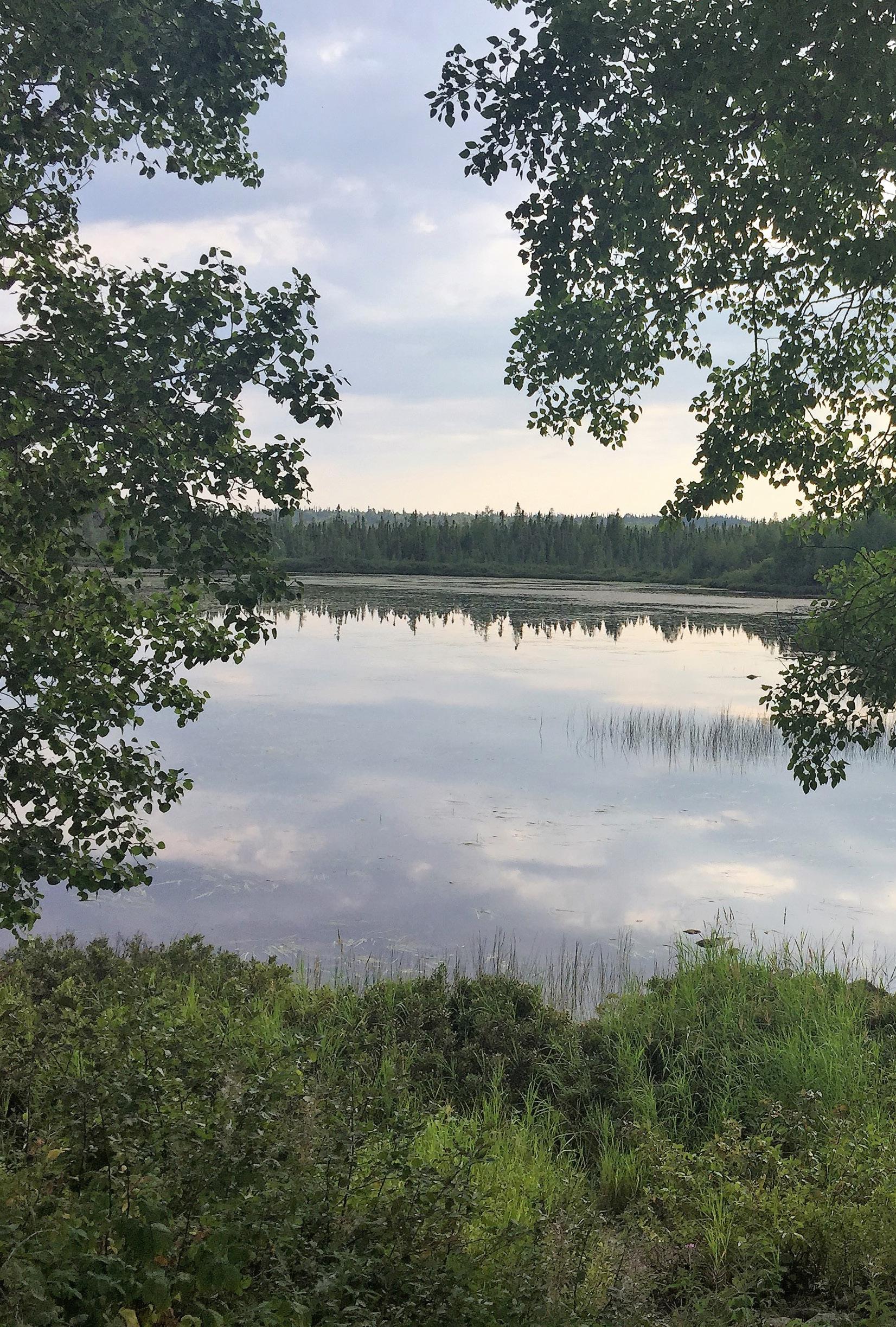
56 Lac Simon


57 Lac Simon

58 Lac Simon
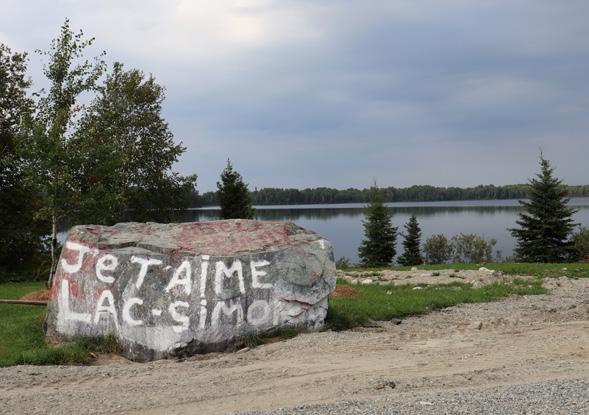
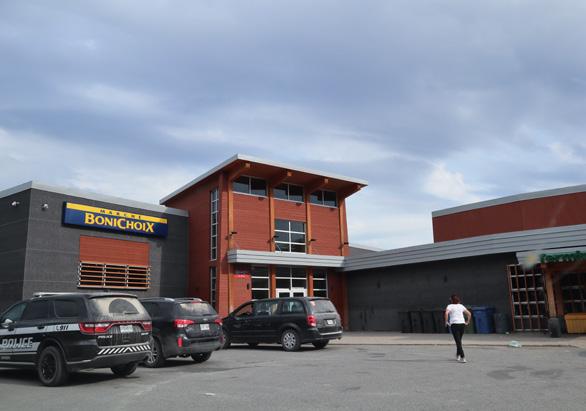


59 Lac Simon

60 Kitcisakik
(secteur Dozois)
KITCISAKIK à la grande embouchure

61
KITCISAKIK
1. Communauté (secteur Dozois) Community
2. Territoire traditionnel (Kitcisakik) Traditional territory
62 2
Territoire de Kitcisakik
63 1km N 1 Rte 117
L a Vérendrye
Val-d’Or
38 (90km)
64 1 12 3 4 5 8 7 6 9 10 11 2 13
Anwatan
Communauté de Kitcisakik (secteur Dozois)
Lac
Rivièredes Outaouais
KITCISAKIK (DOZOIS)
47.6155, -77.307
257 habitants . inhabitants
LaVérendrye38
Lac Nâbikwân
1,51 km2
RTE 117 ROAD
90 km de/from Val-d’Or
93 logements . dwellings
ÉQUIPEMENTS / AMENITIES :
1. École et bibliothèque
School and library
2. Bloc sanitaire
Sanitary block
3. Maison des jeunes
Youth club
4. Terrain de baseball Baseball field
5. Centre d’artisanat et gym
Craft center and gym
6. Génératrice
Generator
7. Barrage Dam
8. Station de pompage et distribution
Pumping station and distribution
9. Centre de santé
Wellness center
10. Conseil de bande
Band council
11. Patinoire couverte
Covered ice rink
12. Centre de la petite enfance
Daycare center
13. Dépanneur
Convenience store
14. Site culturel
Cultural site
15. Scierie
Sawmill
*2021 Statistique Canada Statistic
65 14 15 N 100m (90km)
’or
Val-D
INENIMO
FIERTÉ, APPARTENANCE

66 Kitcisakik (secteur Dozois)
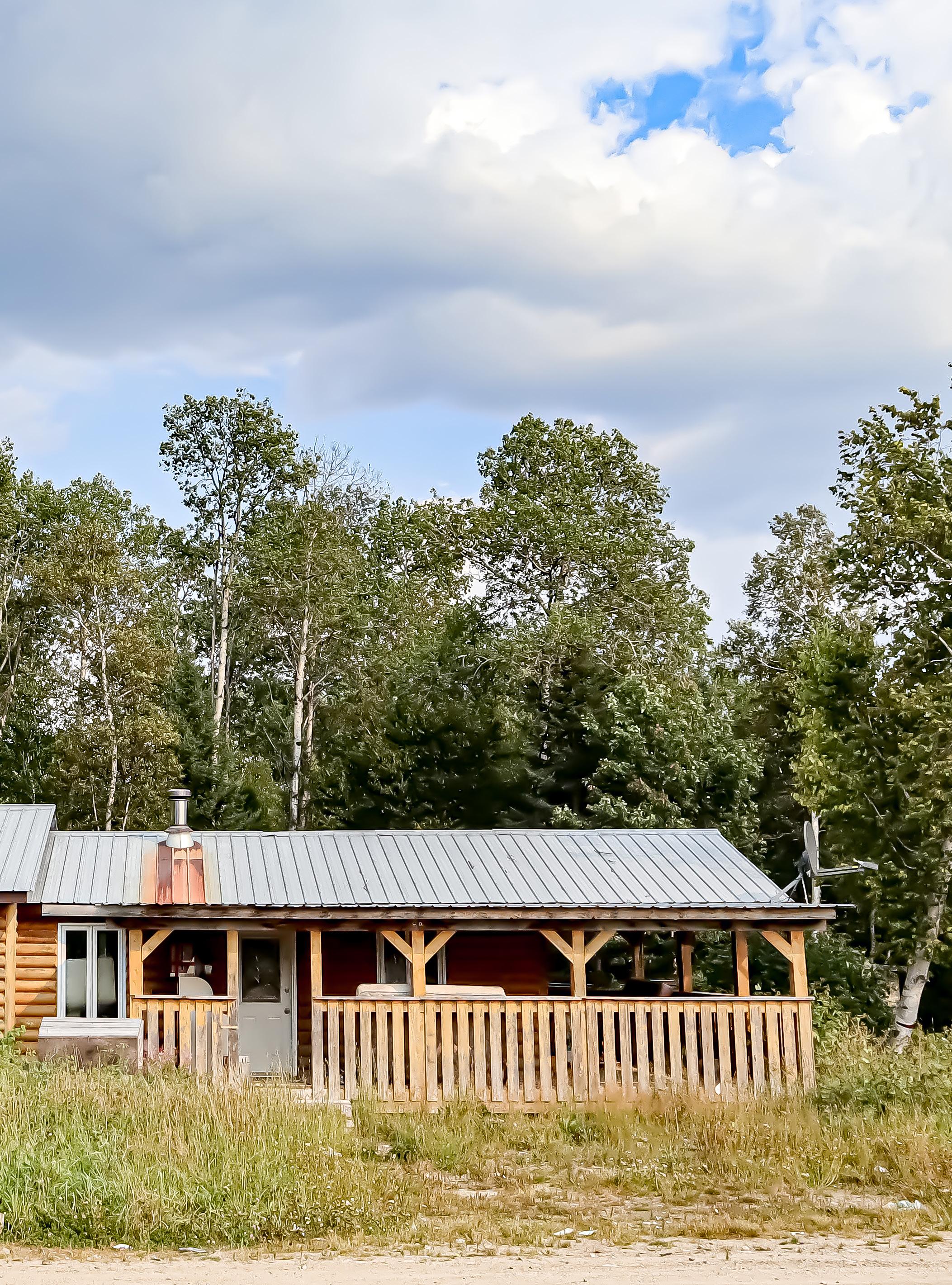
67

68 Kitcisakik (secteur
Dozois)



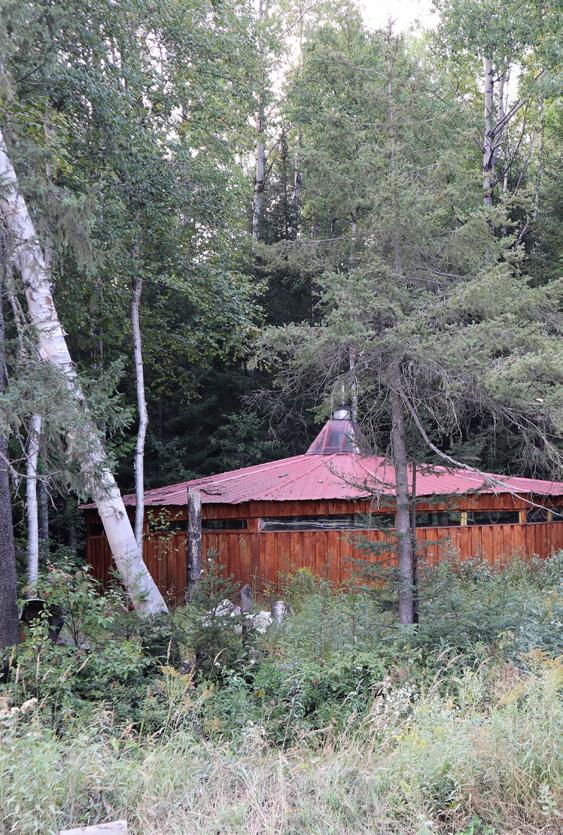
69 Kitcisakik
(secteur Dozois)
Mishta-tshishenniu nitashakush
Nipakashimuan miam eka matenitaman
Ishpimit nuashtemakun
Namaieu nin ka nishtuapatak uashkunu
Tshinikamun
Papeshku nitaitin

Kaukau tshuitamun tshetshi nishtutaman
Atshinu
Tshuishamin
Tshinashatin
Anite ua ituteian
Apu unishinian
MINWASHIN
BEAUTÉ, GRANDEUR, IDÉAL
Kitcisakik
My soul has so many ages
I bathe in a water where I am not
A ceiling lights up my life
I don’t know the tunes
That you hum
I am clumsy
You repeat the movements so that I learn
By heart
The rhythm that leads me
To follow you
In the direction where I don’t go astray
Mon âme a tant d’âges
Je me baigne dans une eau où je ne suis pas
Un plafond éclaire ma vie
Je ne connais pas les airs
Que tu fredonnes
Je suis maladroite
Tu répètes les mouvements pour que j’apprenne Par coeur
Le rythme qui m’entraîne
À te suivre
Dans la direction Où je ne m’égare pas
Joséphine Bacon
Un thé dans la toundra
Nipishapui nete mushuat, 2009

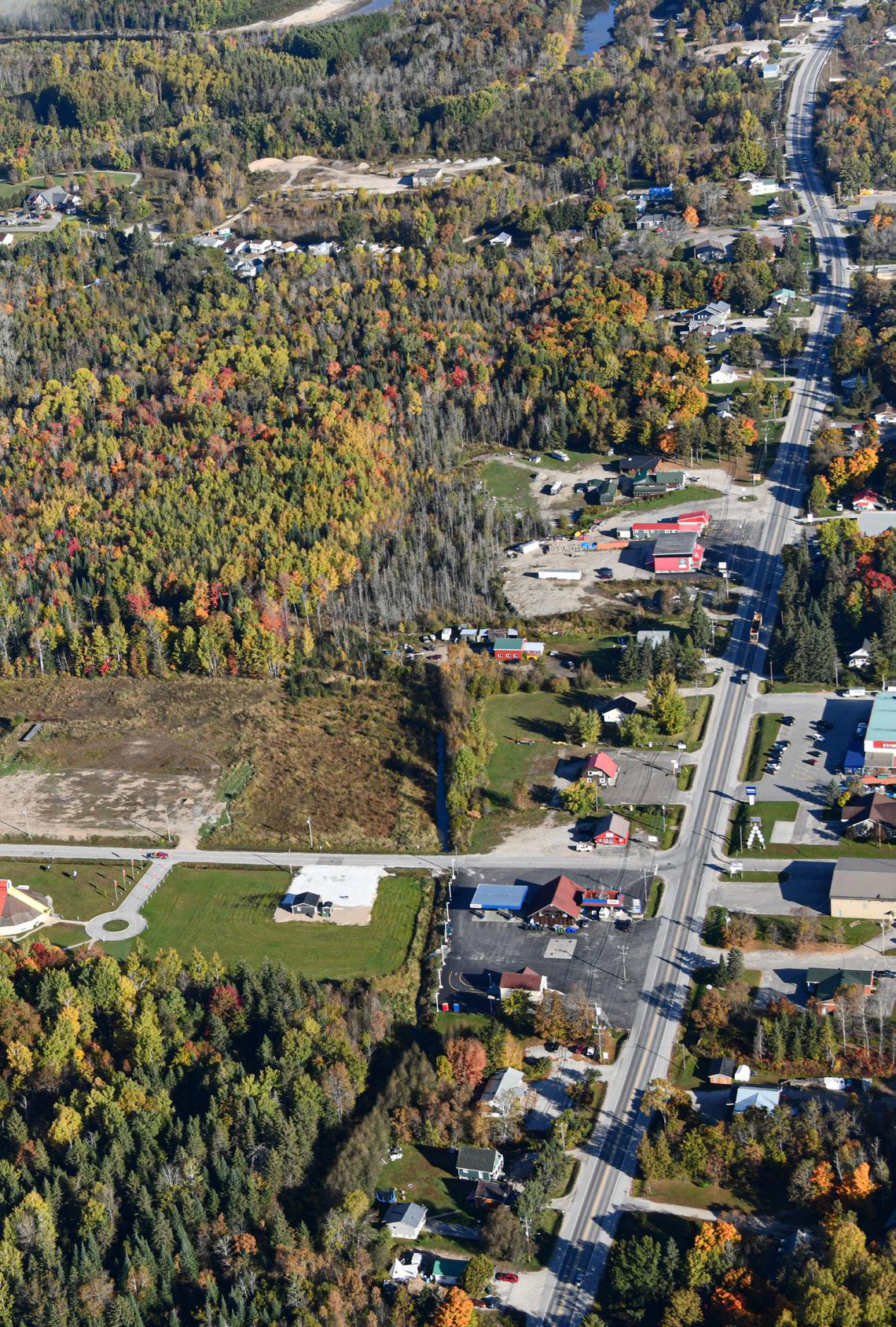
72 Kitigan Zibi
KITIGAN ZIBI
garden river
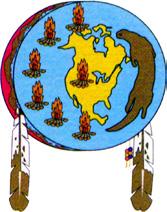
73
KITIGAN ZIBI
A. City of Maniwaki
Ville de Maniwaki
B. Municipality of Messines
Municipalité de Messines
C. Municipality of Déléage
Municipalité de Déléage
AMENITIES / ÉQUIPEMENTS :
1. Wanaki center Centre Wanaki
2. Health and social services Santé et services sociaux
3. Police station
Poste de police
4. Community radio Radio communautaire
5. Kikinamadinan High School
École secondaire Kikinamadinan
6. Pow Wow Grounds
Terrain de Pow Wow
7. Cultural center Centre culturel
8. Nagishkodadiwin park
Parc Nagishkodadiwin
74 1 Kitigan Zibi territory
75 2 3 4 5 6 7 8 N 1km R t e 1 50 R t e 1 0 7 Val-d’Or (285 km) C A B Gatin e a u ( 1 2 7 km)
Education
KITIGAN ZIBI
46.3637,
633
76 1 2 Kitigan Zibi community
-75.9895
1 204 inhabitants . habitants 195,07 km2
RTE 105 ROAD 285 km from/de Val-d’Or
dwellings . logements
AMENITIES / ÉQUIPEMENTS :
1. Sport center Centre sportif
2. Maniwaki speedway Piste de course de Maniwaki
3. Cultural center Centre culturel
4. Gas station Station-service
5. Tribal council Conseil tribal
6. Hardware store Quincaillerie
7. Ski-doo and bicycle path Route cyclable et de ski-doo
8. Band office Conseil de bande
9. Supermarket Supermarché
10. Daycare center Centre petite enfance
*2021 Statistique Canada Statistic
11. Holy Rosary Church Église Saint-Rosaire
KitiganSibi P i t o b ig S t r e a m
12. Kitigan Zibi Community Hall Centre culture de Kitigan Zibil
Mishiginebig lake
center
77 100m N 3 4 5 9 8 7 10 12 11 6 R t e 1 0 5 Gatineau (127 km) Maniwaki
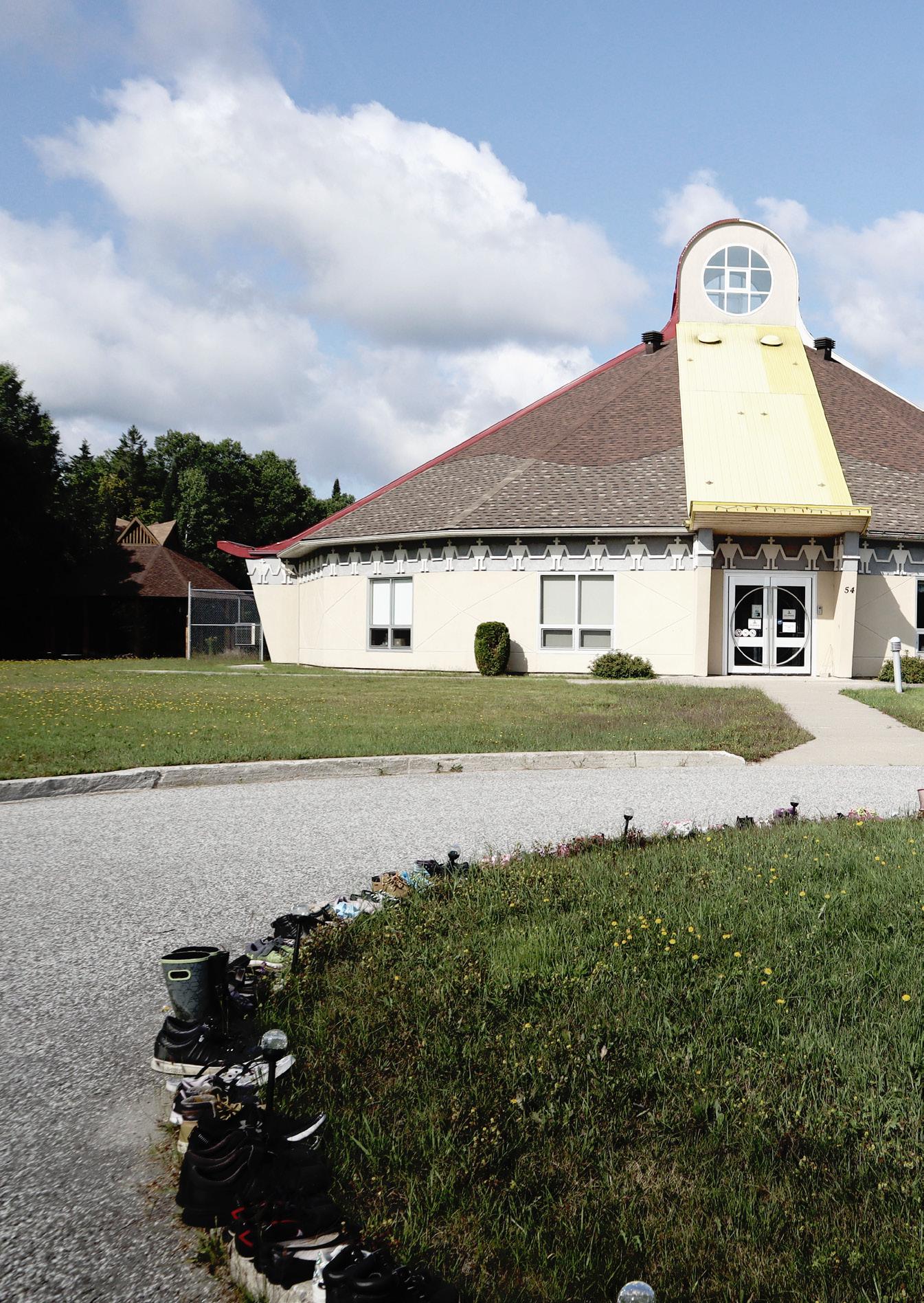


79
Caroline Monnet
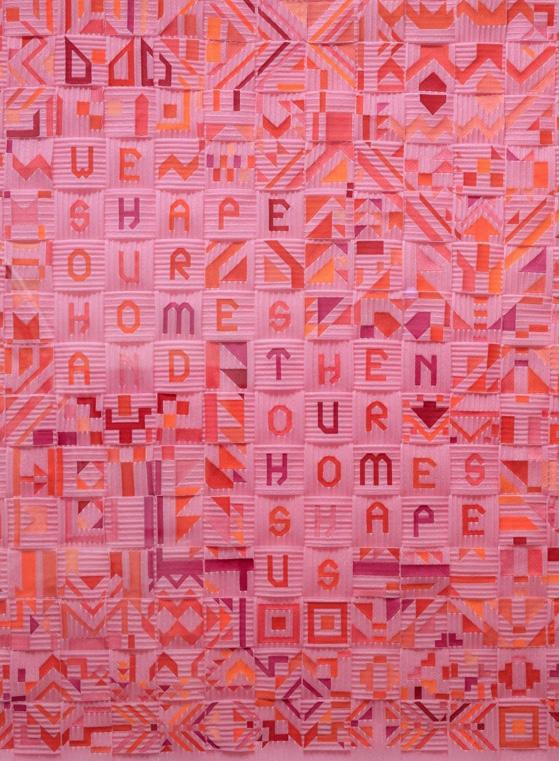
Nous façonnons nos maisons, puis nos maisons nous façonnent.
(Broderie sur bandes d’étanchéité), 2021 © MMFA et Denis Farley photographe Avec permission. With permission
Nadia Myre
Contact in Monochrome (Toile de Jouy), 2018
© Image courtesy of the artist and Art Mûr Avec permission. With permission
81
Rapid Lake
Anite tshinanipaun
tsitshitapamitin
mishtikut tshitashpatshikapaun
tshetshi eka patshishinin
apu uitamut
meshanit tshikassenitamunnu
tshitaitapin
tshitashuapaten
tshetshi mishkuenitamin.
Barricades à Rapid Lake, beauté de la pénombre
je te vois bouleversée, un arbre te soutenant sans que tu lui aies avoué ta souffrance
ton regard fluide n’attend qu’un geste
Barricades at Rapid Lake, beauty of the darkness
I see you overwhelmed, a tree supporting you without you having confessed to it your suffering your fluid gaze is waiting for a gesture
Joséphine Bacon
Bâtons
à message
Tshissinuatshitakana, 2009
82

83 La forêt
et
le tipi, © Anthony Présumé Aquarelle réalisée à Rapid Lake, 2021

84 Rapid Lake
I will style my hair like an arctic reindeer with the resinous moss of the spruce trees eau-de-vie of the gatherings
I remember the peat clammy hands submitted to despair to desire My country oh here is your name coiled between my entrails sand and beaches
moons and stones
Chief of wandering vibrating clearings
stormy taiga
tundras of tumult you call yourself wild you insinuate yourself in my flesh inside
Je me coifferai pareille au renne arctique à la mousse résineuse des épinettes eau-de-vie des cueillettes
Je me souviens la tourbe mains moites soumises au désespoir au désir
Pays mien ô voici ton nom lové entre mes entrailles sable et plages lunes et pierres
Chef de l’errance clairières vibrantes taïgas houleuses toundras du tumulte tu te dis sauvage tu t’insinues en ma chair dedans
85
Natasha Kanapé Fontaine Bleuets et abricots, 2012
SOURCES . CREDITS
C. Baril, p.02-03 — A. Présumé, p.8 — A. Présumé, p.11 — A. Présumé, p.12 — F. Gagnon, p.17 — Photos d’archive. Repéré à URL : (1) thecanadianencyclopedia.ca/fr/article/ reserves-en-quebec (2) numerique.banq.qc.ca/patrimoine/details/52327/3324608 (3) numerique.banq.qc.ca/patrimoine/details/52327/2482807 (4) firstpeople.us/tipi/ ojibwa-indian-camp-with-birch-bark-canoe.html (5) numerique.banq.qc.ca/patrimoine/ details/52327/4402163?docref=20jA8N4UcdgE_vV-AGFIUQ (6) numerique.banq. qc.ca/patrimoine/details/52327/3123235 (7) numerique.banq.qc.ca/patrimoine/ details/52327/2432167 (8) histoirecanada.ca/consulter/politique-et-droit/territoirealgonquin, p.20 — E. Gouin, p.26 — A. Présumé, p.28 — Polson, Frank. Winneway. Repéré à URL : minwashin.org, p.28 — A. Présumé, p.30 — P. Lahoud, p.30 — Emblême de Rapid Lake, p.31 — Canada - Mines and technical surveys, p.32-33 — S-L. Gagnon-Villeneuve, p.40 — Photos de S. Boudreault et F. Gagnon, p.41— S. Boudreault, p.42 — Grace Ratt. Repéré à URL : minwashin.org/artistes/grace-ratt-jerome, p.43 — P. Lahoud, p.44 — Emblême de Pikogan, p.45 — F. Gagnon, p.48 — Photos de F. Gagnon, p.50 — P. Lahoud, p.52 — Emblême de Lac Simon, p.53 — E. Gouin, p.56 — F. Gagnon, p.57 — E. Gouin, p.57 — F. Gagnon, p.58
— Photos de S. Boudreault et F. Gagnon, p.59 — P. Lahoud, p.60 — Emblême de Kitcisakik. p.61 — Photos de F. Gagnon, p.66-71 — P. Lahoud, p.72 — Emblême de Kitigan Zibi, p.73
— Photos de F. Gagnon, p.78-79 — Monnet, Caroline. (2021). Ninga Mìnèh [Exposition], Musée des beaux-arts Montréal, Montréal, Qc, Canada. mbam.qc.ca/fr/expositions/ caroline-monnet-ninga-mineh, p.80 — Myre, Nadia. (2018). Contact in Monochrone, [Toile de Jouy]. Galerie Art Mûr, Montréal, Qc, Canada, p.81 — A. Présumé, p.83 — S.-L. GagnonVilleneuve, p.84
86
RÉFÉRENCES . REFERENCES
Bacon, Joséphine (2009). Un thé dans la toundra / Nipishapui nete mushuat. Montréal, QC : Mémoire d’encrier, p. 58.
Bacon, Joséphine (2009). Bâtons à message / Tshissinuatshitakana. Montréal, QC : Mémoire d’encrier, p. 102.
Bouchard, Serge (2021). Un café avec Marie. Montréal, QC : Boréal, p. 135.
Kanapé Fontaine, Natasha (2012). Bleuets et abricots. Montréal, QC : Mémoire d’encrier, p. 20.
Kistabish, Richard [Ejinagosi] (1989). Pour le monde qui aime la terre, Traces, 27 (1), p. 23.
Monnet, Caroline (2021, 13 mai). Douce revendicatrice. https://www.pressreader.com/ canada/elle-quebec/20210513/283278870664262.
Samian (2015). La plume d’aigle. Montréal, QC : Mémoire d’encrier, p. 9.
Samian [@SamianOfficiel] (2022, 2 mars)[Tweet]. Twitter. https://twitter.com/ SamianOfficiel/status/1499049873060020230.
Ratt, Grace (2022). Artistes et porteurs culturels. https://minwashin.org/artistes/ grace-ratt-jerome.
Vachon, Geneviève; Gouin, Élisa; et Boudreault, Samuel (2023). « La réconciliation dans l’action : construire un cadre collaboratif d’aménagement avec une communauté anishinaabe », Urbanité, Volume printemps-été, p. 26-29. Avec les contributions de Norman Matchewan (ABL) et Hugo Lavallée (MTMDQ). https://ouq.qc.ca/revues/.
Wall Kimmerer, Robin (2021). Tresser les herbes sacrées: Sagesse ancestrale, science et enseignements des plantes. Paris : Le lotus et l’éléphant, p. 195 et 286.


| @hlnq.linq
www.habiterlenordquebecois.org



























































































































